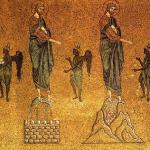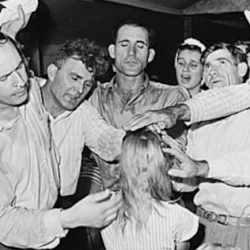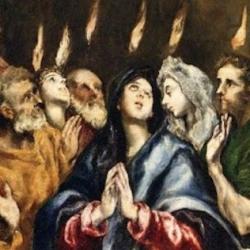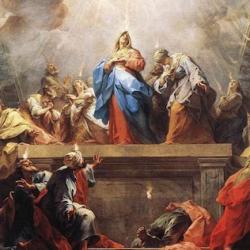The Azusa Street Revival that launched the Pentecostal movement was accompanied by a burst of racial reconciliation. An Anglican visitors marveled:
“It was something very extraordinary, that white pastors from the South were eagerly prepared to go to Los Angeles to the Negroes, to have fellowship with them and to receive through their prayers and intercessions the blessing of the Spirit. And it was still more wonderful that these white pastors went back to the South and reported to the members of their congregations that they had been together with Negroes, that they had prayed in one Spirit and received the same blessings as they” (quoted in Iain MacRobert’s The Black Roots and White Racism of Early Pentecostalism, 56).
MacRobert goes on: “Mattie Cummings reported that at Azusa: ‘Everybody was just the same, it did not matter if you were black, white, green or grizzly. There was a wonderful spirit. Germans and Jews, black and whites, ate together in the little cottage at the rear. Nobody ever thought of color.’ When the congregation at Azusa Street organised itself into the Apostolic Faith Gospel Mission, the twelve elders comprised three blacks and nine whites of which five were men and seven women. The barriers of race and sex had been broken down in the pulpit as well as the pew” (56).
William Seymour, whose ministry sparked the revival, wrote, “Our colored brethren must love our white brethren and respect them in the truth so that the word of God can have its free course, and out white brethren must love their colored brethren and resraect them in the truth so that the Holy Spirit won’t be grieved” (quoted 68).
It didn’t last.
Visiting Azusa Street in October 1906, Charles Fox Parham didn’t like what he saw. He was repulsed by “white people imitating the unintelligent, crude negroisms of the Southland, and laying it on the Holy Ghost” (quoted 60). Writing later of the “animalism” of the meetings, he said, “I have seen meetings where all crowded together around the altar, and laying across one another like hogs, blacks and whites mingling; this should be enough to bring a blush of shame to devils, let alone angels, and yet all this was charged to the Holy Spirit” (quoted 60).
Racism wasn’t accidental to Parham’s outlook. He believed that the Aryan races descended from the sons of Israel; Saxons are “Isaac’s sons.” He sketched the racial-religious constitution of humanity in these terms: “the descendants of Abraham are the Hindus, the Japanese, the high Germans, the Danes (tribe of Dan) the Scandinavians, the Anglo-Saxons and their descendants in all parts of the world. These are the nations who have acquired and retained experimental salvation and deep spiritual truths; while the Gentiles, – the Russians, the Greek, the Italian, the low German, the French, the Spanish and their descendants in all parts are formalists, scarce ever obtaining the knowledge and truth discovered by Luther – that of justification by faith or the truth taught by Wesley, sanctification by faith; while the heathen, – the Black race, the Brown race, the Red race, the Yellow race, in spite of missionary zeal and effort are nearly all heathen still; but will, in the dawning of the coming age be given to Jesus for an inheritance” (61).
During the 1920s, Parham wrote and preached for overtly racist organizations (62).
Parham was an aberration, but a hint of the difficulty of maintaining William Seymour’s initial interracial vision for the movement. Racial division occurred more subtly. When William H. Durham took over the mission during Seymour’s absence in 1911, he ignited a theological controversy regarding sanctification. By the time he died in 1912, he had split the movement, not only theologically but racially:
“His contentious and sectarian views had by this time split the Pentecostal movement. On the question of sanctification there was no room for dialogue. He condemned and ridiculed the beliefs of his opponents. Glossolalia was for him the only evidence of a person having received the Holy Spirit. Seymour, on the other hand, while accepting glossolalia as the initial evidence, believed it to be but one of the manifestations of the Spirit. While Seymour consistently sought for a multi-racial movement, Durham rejected him and formed a movement dominated by whites” (63).
Durham was only the first: “All of the white Pentecostal leaders sooner or later separated themselves from Seymour and Azusa. Their rationalisations for doing so varied as did the time of their leaving, but ultimately the whites split away from Seymour and their black religious origins, and Seymour’s dream of equality and interracial fellowship was left in tatters” (64).
By 1914, the Church of God in Christ had become the center of black Pentecostalism, while the Assemblies of God were a predominantly white church. MacRobert concludes that race played a role in nearly every division of the Pentecostal movement (66).











